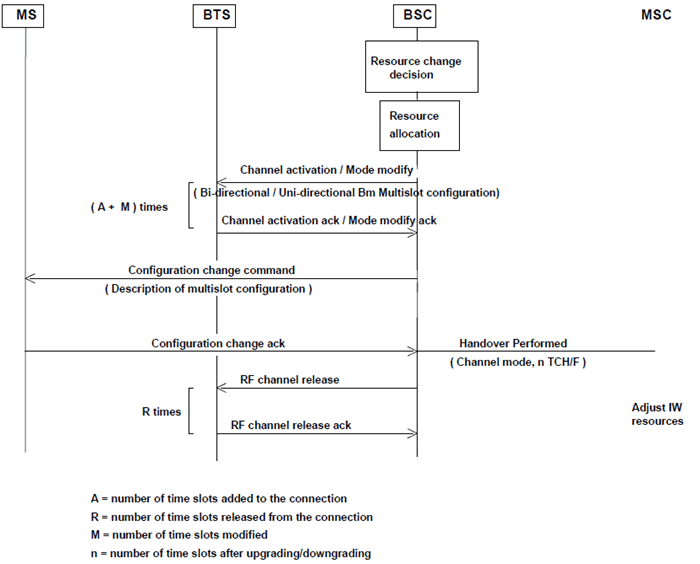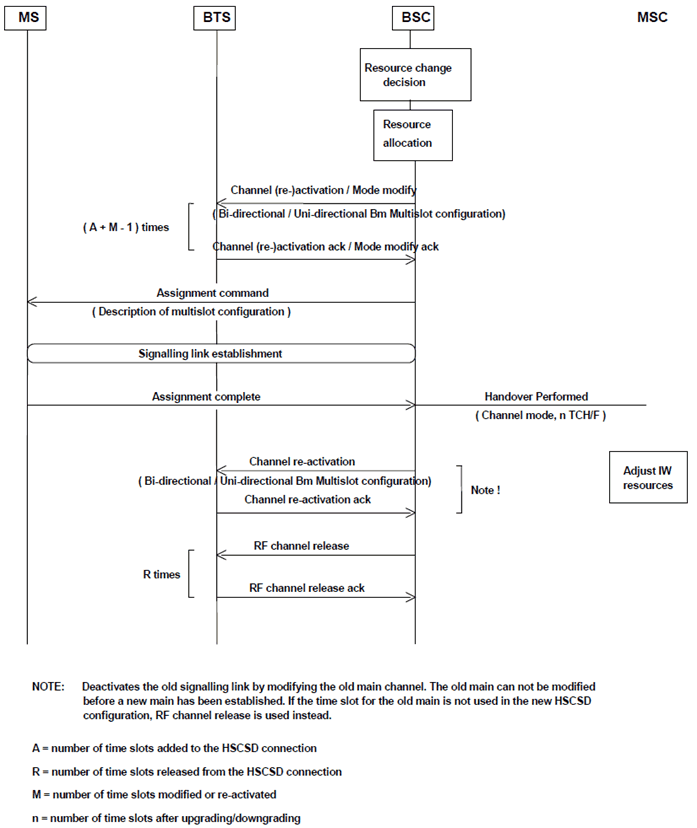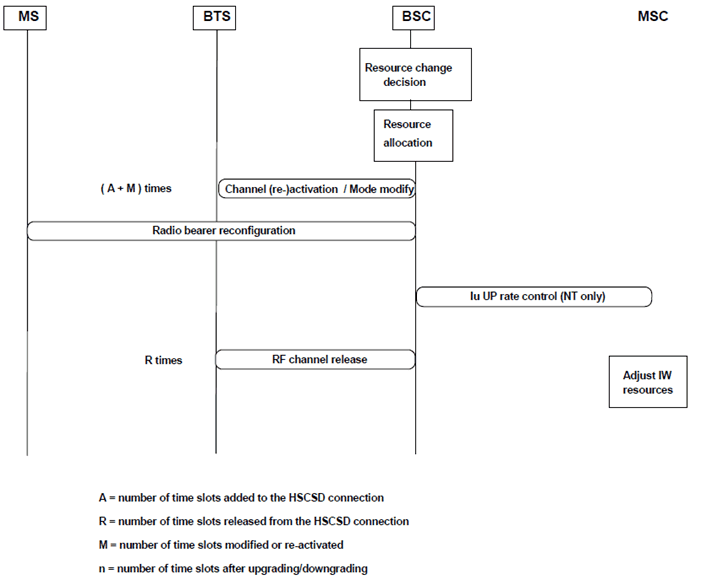Content for TS 23.034 Word version: 18.0.0
5.2.3 Resource upgrading, downgrading and configuration change (A/Gb mode)
5.2.3a Resource upgrading, downgrading and configuration change (GERAN Iu mode)
...
...
5.2.3 Resource upgrading, downgrading and configuration change (A/Gb mode) p. 20
Resource upgrading means allocating more channels to the HSCSD configuration. Similarly, in resource downgrading channels are released.
Both of these procedures are initiated by the network and they are used in non-transparent calls to alter the channel resources between one TCH/F and the maximum number of TCH/F allowed. For transparent connection the alteration of resources is also applicable required that the AIUR for the connection remains constant.
Figure 7 depicts the procedures for a successful resource upgrading and downgrading for an ongoing HSCSD call in A/Gb mode, in case the position of the main TCH/F remains unchanged.
A separate channel activation for the new HSCSD channels is carried out and the earlier activated HSCSD channels may be modified, before RR Configuration change procedure is used for forwarding the new channel configuration to the mobile station. Similarly, the Configuration change procedure can be used in both transparent and non-transparent calls for reordering the channels in a call without changing the number of TCH/Fs allocated.
At resource modification completion, the BSC signals to the MSC the new HSCSD configuration and the MSC may adjusts the IW resources accordingly.

Figure 7: Resource upgrading and downgrading in A/Gb mode, the position of the main channel unchanged
(⇒ copy of original 3GPP image)
(⇒ copy of original 3GPP image)
Figure 8 depicts the procedures for a successful resource upgrading and downgrading for an ongoing HSCSD call in A/Gb mode in case the position of the main channel is changed.
A separate channel activation for the new HSCSD channels, is carried out and the earlier activated HSCSD channels may be modified or, in case of the new main channel, reactivated, before RR Assignment procedure is used for forwarding the new channel configuration to the mobile station. Similarly, the Assignment procedure can be used in both transparent and non-transparent calls for reordering the channels in a call without changing the number of TCH/Fs allocated.
At resource modification completion, the BSC signals to the MSC the new HSCSD configuration and the MSC may adjusts the IW resources accordingly.

Figure 8: Resource upgrading and downgrading in A/Gb mode, the position of the main channel changed
(⇒ copy of original 3GPP image)
(⇒ copy of original 3GPP image)
5.2.3a Resource upgrading, downgrading and configuration change (GERAN Iu mode) |R5| p. 22
In GERAN Iu mode a Radio bearer reconfiguration procedure is used for forwarding the new channel configuration to the mobile station, regardless whether the position of the main channel is changed or not.
Figure 8a depicts the procedures for a successful resource upgrading and downgrading for an ongoing HSCSD call in GERAN Iu mode, in case the position of the main TCH/F remains unchanged.

Figure 8a: Resource upgrading and downgrading in GERAN Iu mode, the position of the main channel unchanged
(⇒ copy of original 3GPP image)
(⇒ copy of original 3GPP image)
The outcome of the procedure shall be reported to the MSC by means of an Iu UP rate control procedure (see TS 25.415). The BSC shall set the maximum rate permitted downlink over the Iu interface according to the new HSCSD configuration, i.e. according to the AIUR to be used by the IW function when the communication is resumed after the handover. The BSC shall use the same RAB subflow combination in uplink direction.
For a transparent call in GERAN Iu mode, the resource upgrading or downgrading is not applicable since the AIUR remains unchanged during the call, and the allowed radio interface data rate is set by the MSC.